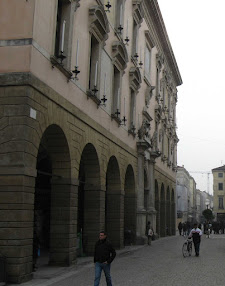Vittorino da
Feltre, a scholar who was considered to have been the greatest humanist
educator of the Renaissance, owed his success partly to the education he had
received at the University of Padua.
Vittorino da Feltre both studied
and taught at Padua University
Da Feltre,
who was originally named Vittore dei Ramboldini when he was born in Feltre in the
republic of Venice in 1378, went to study and then taught at the University of
Padua. He later chose to settle in Padua and he became a successful teacher,
welcoming pupils into his own home and varying his fee according to the
financial situation of the pupil’s family.
He himself
had come from a good family that had become impoverished and his own early
education had been a struggle. This contributed to making him a strong and
decisive character and made him leave his home in Feltre when he was 18 to go
to Padua.
He supported
himself financially while studying grammar and Latin at the university under
Gasparino da Barzizza, the greatest Latin scholar of the age, by teaching
grammar to children.
After
receiving his degree of doctor of arts in Latin composition and logic, he began
the study of mathematics. By 1415, Da Feltre was teaching both grammar and mathematics in Padua. He took students to live in his house and closely supervised
their activities.
He was
promoted to Chair of Rhetoric in Padua in 1422 and became one of the most popular
teachers at the university.
In 1423, he was
asked to become tutor to the children of the powerful Gonzaga family, who ruled
over Mantua. He agreed to do this providing he could set up his own school away
from the Gonzaga court and its political influence.
Palazzo Bo, part of the University of
Padua, where Da Feltre taught
He also enrolled
other children to be taught at the school along with the Gonzaga children, both
noble and poor children, who were selected because of their ability. The poor
children did not have to pay for their education and were taught on an equal
footing with the children from wealthy families. He also educated girls and did
not consider the female pupils to be inferior to the male pupils.
Latin and
Greek language and literature were at the centre of the curriculum of the
school. The children were also taught arithmetic, geometry and music and did
games and physical exercise, following the Greek ideal of development of the
body as well as of the mind. The school was close to a lake and surrounded by
beautiful countryside, which also contributed to the wellbeing of the pupils.
Da Feltre saw
education as a pathway to living a Christian life and made his pupils feel
loved and cared for in terms of their health and characters. He adapted his
teaching methods to their individual abilities and needs and never used
corporal punishment. Among his students were Federico da Montefeltro, who
became Duke of Urbino, and Gregorio Correr, who became Patriarch of Venice.
Federico da Montefeltro was
among Da Feltre's pupils
One of the
first modern educators to develop during the Renaissance, da Feltre’s teaching
methods were therefore innovative and many other schools in Europe were to adopt
his educational model.
During his
career, Da Feltre not only educated future Italian rulers and professional men but
also taught Latin and Greek scholars who came to him from the east. This paved
the way for the translation of the Greek manuscripts that were to inspire the
Renaissance in Europe.
After Da Feltre’s death at the age of 68 in Mantua, Iacopo da San Cassiano, a humanist and mathematician who had been one of his pupils, took over the running of the school and inherited his library. Da Feltre was laid to rest in the Chiesa di Santo Spirito in Mantua.